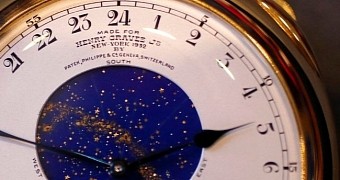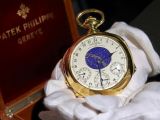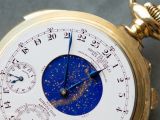Just yesterday, a pocket watch sold for a whopping £15.1 million ($24 million / €19.3 million) at an auction organized by Sotheby's in Geneva, Switzerland's second most populous city.
Prior to the auction held in Geneva this past November 11, the very same pocket watch was last sold back in 1999 at another event held by Sotheby's in New York City, US.
At that time, the watch fetched ₤6.9 million ($11 million / €8.8 million), which was more than anyone had ever paid for a pocket watch before.
Given the outcome of yesterday's auction in Geneva, Sotheby's wishes to point out that this pocket watch, dubbed The Henry Graves Supercomplication, has until now sold for a world record price not once, but twice.
“Tonight, The Henry Graves Supercomplication re-established its supreme status as the most valuable timepiece in auction history, selling CHF 23.2 million ($24 million / €19.3 million / £15.1 million), thereby beating the record of $11 million it established in 1999,” the auction house explains.
So, who bought the watch?
Information shared with the public says that a total of five bidders dug deep in their pockets looking to take the watch back home with them. The auction lasted about 15 minutes and was won by a man wearing a tie.
The identity of this mysterious man has not yet been revealed, and by the looks of it, we may never know who he is. Thus, it is understood that this bidder who won the auction and acquired the pocket watch insists that he remain anonymous.
“Five bidders competed for this masterpiece of horology which went to an anonymous buyer in the room after 15 minutes of suspense,” reads a statement issued by auction house Sotheby's shortly after the sale was done with.
What makes this pocket watch so special?
The pocket watch is the creation of Patek Philippe & Co., a Swiss luxury watch manufacturer founded in 1852 by Polish watchmaker Antoni Patek and French watchmaker Adrien Philippe.
According to historical records, it was in 1925 that a New York banker named Henry Graves commissioned Patek Philippe & Co. to make him this watch. Three years of research and five years of work later, the watch was completed.
The Henry Graves Supercomplication is said to be the most complex watch ever made without the help of computers. Thus, it does not just show the hour, but also offers information concerning moon phases, sidereal time and time of sunset and sunrise in New York City.
Sotheby's says that, despite the fact that it was last wound in 1969, the watch is still in working order. Otherwise put, its new owner can in fact use it to tell the time. Then again, chances are that he'll just put it someplace safe and only take it out every once in a while to look at it.
Commenting on the sale of this one-of-a-kind pocket watch in Geneva, Switzerland, Daryin Schnipper with Sotheby's said, “This stellar result confirms the 'rockstar' status of The Henry Graves Supercomplication.”
Furthermore, “It is more than a watch. It is a masterpiece which transcends the boundaries of horology and has earned its place among the world's greatest works of art. The fascination it has attracted over the past few months, as Patek Philippe celebrates its 175th anniversary, is a fitting tribute to the genius of the Swiss manufacturer.”

 14 DAY TRIAL //
14 DAY TRIAL // 



